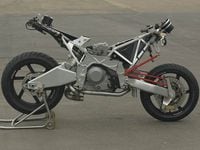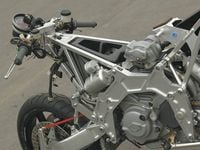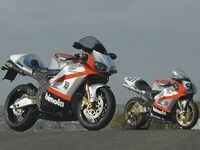Bimota is back. Thanks once again to the largess of Italian ultra-entrepreneur Roberto Comini (who bankrolled Bimota's last failed comeback), the Rimini-based boutique-bike manufacturer now offers three new models. Two of them are conventional--for Bimota, anyway--and powered by 996cc Suzuki V-twin engines, the SB8K Gobert Replica and the Santa Monica. But as if to highlight Bimota's phoenix-like revival from the ashes, there's also the reborn Tesi 2D, a modern iteration of the Ducati 888-powered Tesi 1D I raced for Bimota more than a decade ago, winning the ProTwins class twice at Daytona.
Previously, Bimota technician Ascanio Rodorigo made a deal with the company to take the Tesi concept and re-engineer it around Ducati's much less costly (and more modern) desmodue engine, the 1000DS. Rodorigo named the resulting motorcycle the Vyrus. Comini's revived Bimota motorcycle company, however, will market the Vyrus as the more appropriately named Tesi 2D.
For me, the chance to ride a prototype street version at Misano was a trip down memory lane. The newest version is better than the original Tesi 1D, mainly because the air/oil-cooled desmo engine is the right tool for the job, and the Double System air shocks front and rear deliver more compliance and control than the 1D's conventional Oehlins hardware. Free of the weight and bulk of the previous eight-valve desmo V-twin, the new-generation 2D is smaller, shorter, lighter and refreshingly agile. Propelling its 339 pounds (dry) with 77 rear-wheel horsepower, the Bimota accelerates with enthusiasm up to 9000 rpm with very little vibration. After remembering you can trail-brake a Tesi hard into a turn without losing the front end, I started enjoying myself more and more until I ran out of petrol.
At $47,868 in Italy, the Tesi 2D is hardly inexpensive. But it's genuinely different from anything else, and fittingly quite rare; only 30 will be built this year. Moreover, the 2D's lack of bodywork and its cheeky stance are an aesthetic improvement over its slab-sided Tesi 1D predecessor. Sharing only its overall architecture with the original, the Tesi 2D is a brilliantly functional technological tour de force.














/cloudfront-us-east-1.images.arcpublishing.com/octane/HXOUJXQWA5HBHGRO3EMJIGFMVI.jpg)

/cloudfront-us-east-1.images.arcpublishing.com/octane/3TIWWRV4JBBOLDVGRYECVVTA7Y.jpg)
/cloudfront-us-east-1.images.arcpublishing.com/octane/KIX5O23D5NAIBGFXBN3327DKZU.jpg)
/cloudfront-us-east-1.images.arcpublishing.com/octane/7GJYDUIPXRGMTMQKN6ONYOLBOU.jpg)
/cloudfront-us-east-1.images.arcpublishing.com/octane/MUQLOVLL2ZDGFH25ILABNBXKTI.jpg)
/cloudfront-us-east-1.images.arcpublishing.com/octane/TNOU5DNE2BC57MFPMGN2EIDXAM.jpg)
/cloudfront-us-east-1.images.arcpublishing.com/octane/GTCXACQGJ5HAPDTGWUQKDEH44E.jpg)
/cloudfront-us-east-1.images.arcpublishing.com/octane/S35YGSEMEZB4BLTDJTSZPF4GLA.jpg)
/cloudfront-us-east-1.images.arcpublishing.com/octane/5UOT6HPX2JFMRJAX6EH45AR4MQ.jpg)
/cloudfront-us-east-1.images.arcpublishing.com/octane/OKWOJWAKP5EP3OACCRRWPCIX2Q.jpg)
/cloudfront-us-east-1.images.arcpublishing.com/octane/2WF3SCE3NFBQXLDNJM7KMXA45E.jpg)
/cloudfront-us-east-1.images.arcpublishing.com/octane/G4MG6OUCJNBSHIS2MVVOTPX65E.jpg)
/cloudfront-us-east-1.images.arcpublishing.com/octane/IIGGWFOTOJGB7DB6DGBXCCMTDY.jpg)
/cloudfront-us-east-1.images.arcpublishing.com/octane/QSTCM6AVEZA5JJBUXNIQ3DSOF4.jpg)
/cloudfront-us-east-1.images.arcpublishing.com/octane/U4I7G625B5DMLF2DVIJDFZVV6M.jpg)
/cloudfront-us-east-1.images.arcpublishing.com/octane/B6XD6LS6IVCQPIU6HXDJSM3FHY.jpg)
/cloudfront-us-east-1.images.arcpublishing.com/octane/ICL63FEDDRDTTMINYICCEYGMDA.jpg)
/cloudfront-us-east-1.images.arcpublishing.com/octane/FCGZHQXRBZFLBAPC5SDIQLVF4I.jpg)
/cloudfront-us-east-1.images.arcpublishing.com/octane/WNOB6LDOIFFHJKPSVIWDYUGOPM.jpg)

/cloudfront-us-east-1.images.arcpublishing.com/octane/X33NU3E525ECRHXLNUJN2FTRKI.jpg)
/cloudfront-us-east-1.images.arcpublishing.com/octane/6KKT5NNL2JAVBOXMZYS5ZO76YA.jpg)
/cloudfront-us-east-1.images.arcpublishing.com/octane/J5RKG5O455GMPGQRF2OG6LRT7A.jpg)